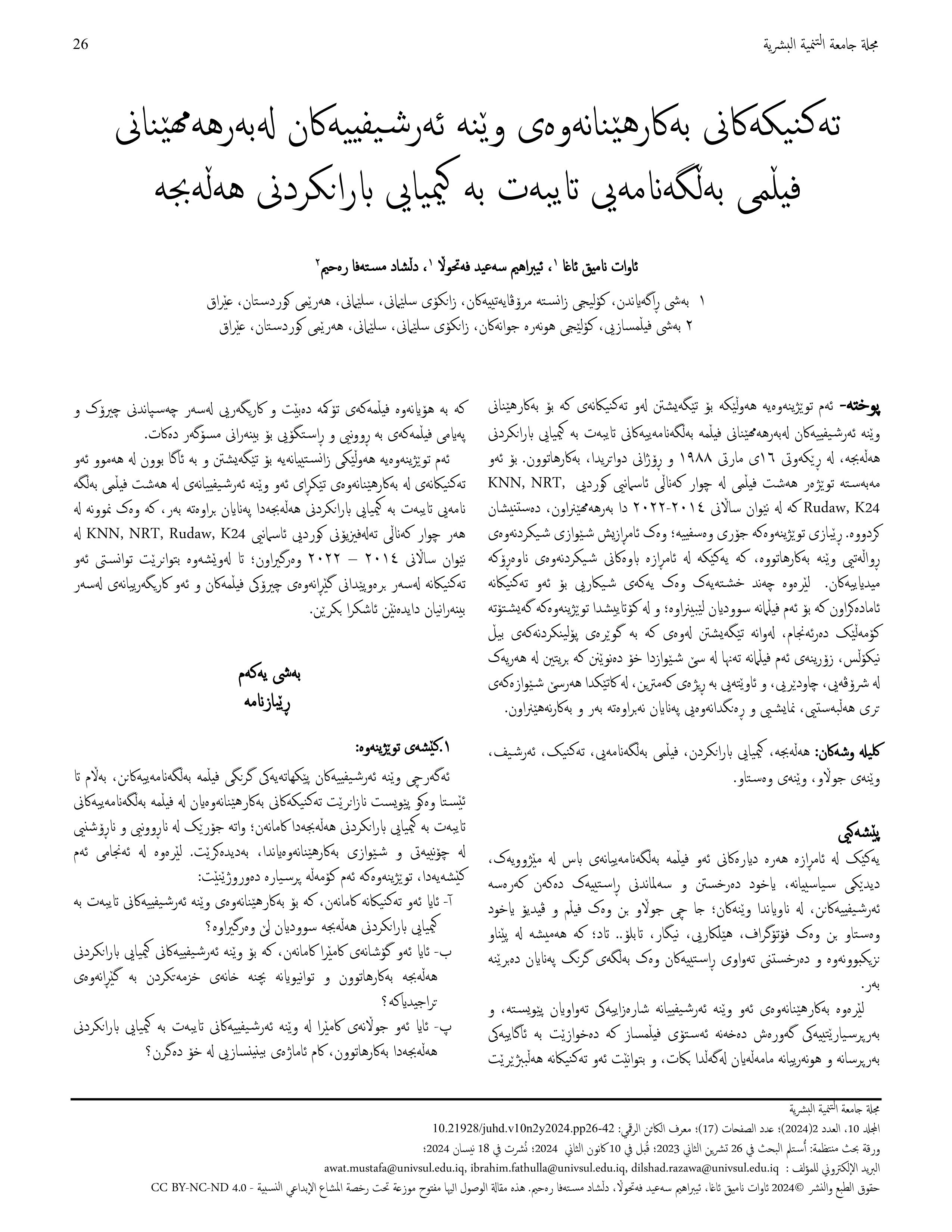The Techniques of Reusing Visual Archives in the Production of Special Documentary Films on the Chemical Attack on Halabja’
DOI:
https://doi.org/10.21928/juhd.v10n2y2024.pp26-42Keywords:
Halabja, Chemical Attack, Documentary Films, Filmmaking Techniques, Archival Material, Motion Images (Videos & Films), Still Images (Photographs)Abstract
This research is centred on analysing the techniques employed in repurposing archival images pertaining to the chemical attacks in Halabja, which occurred on March 16, 1988, and their subsequent aftermath.
To achieve this objective, the researcher has chosen eight films that were both produced and broadcasted on four Kurdish satellite channels (KNN, NRT, Rudaw, K24) during the period spanning from 2014 to 2022, garnering notable recognition.
The research employs a descriptive methodology, utilizing visual analysis of images as a prominent tool, recognized widely for its efficacy in dissecting media content. Consequently, a series of tables were meticulously crafted to serve as units for scrutinizing the techniques employed in these films.
Ultimately, the research yielded several findings, foremost among them being the observation that the majority of these films, classified according to Bill Nichols’s taxonomy, predominantly manifest in three modes: expository, observational, and interactive, albeit in a limited percentage. Conversely, the poetic, performative, and reflexive categories were notably absent in the examined films.
References
سەرچاوە ئینگلیزییەکان
Books
Buckland, W. (1998). Film Studies. Hodder & Stoughton. UK.
Dorling Kindersley Limited (DK) & Oxford University Press. (1998). Illustrated Oxford Dictionary. Dorling Kindersley Limited and Oxford University Press. Great Britain
Fiske, J. (2001). Television Culture (11th ed.). Routledge. London, New York.
Katz, S. D. (1991). Film Directing, Shot by Shot: Visualizing from Concept to Screen. USA.
Kuhn, A., & Westwell, G. (2020). Oxford Dictionary of Film Studies (2nd ed.). Oxford University Press. United Kingdom.
LoBrutto, V. (2002). The Filmmaker’s Guide to Production Design. Allworth. New York.
Monaco, J. (1981). How to Read a Film: The Art, Technology, Language, History, and Theory of Film and Media (Revised Edition). New York; Oxford: Oxford University Press.
Top of Form
Nichols, B. (1991). Representing Reality. Indiana University Press. USA.
Nichols, B. (2017). Introduction to Documentary (3rd ed.). Indiana University Press. USA.
Phillips, W. H. (1999). Film: An Introduction. Bedford/St. Martin’s. Boston, MA, USA.
Rabiger, M. (2004). Directing the Documentary (4th ed.). Focal Press. USA.
Van Sijll, J. (2005). Cinematic Storytelling: The 100 Most Powerful Film Conventions Every Filmmaker Must Know. USA.
Websites: (Internet Articles and Notes)
ICA: International Council on Archives. (n.d.). What Are Archives? Retrieved from https://www.ica.org/en/what-archive (Cited on: February 12, 2023, at 21:43)
Johnson, J. P. (n.d.). An Animation in Documentary: A Beautiful Paradox. Film Obsessive. Retrieved rom https://filmobsessive.com/film/film-analysis/film-genres/documentaries/animation-in-documentary-a-beautiful-paradox/
KNN TV. (n.d.). Retrieved from https://apps.apple.com/kw/app/knn-tv/id1406349580?l=ar
Kurdistan24. (n.d.). About Kurdistan 24. Retrieved from https://www.kurdistan24.net/ckb/about
Merriam-Webster. (N/A). Still Photograph. Retrieved from https://www.merriam-bster.com/dictionary/still%20photograph
nrtOne TV. (2021, May 5). Retrieved from https://play.google.com/store/apps/details?id=com.nrtOne.tv&hl=en&gl=US&pli=1
Rudaw Media Network. (n.d.). About Rudaw Media Network. Retrieved from https://www.rudaw.net/english/about#:~:text=Rudaw%20Media%20Network%20is%20an,manner%20as%20its%20main%20goal.
Selway, K. (2017, August 29). Bill Nichols' 6 Modes of Documentary. Retrieved from https://liftoff.network/bill-nichols-6-modes-documentary
(Cited on: February 14, 2022, at 00:36)
Masterclasses
"Master Class, Ken Burns Shares 9 Useful Tips for Sourcing Archival Footage." (2021, June 7). Masterclass. Retrieved from https://www.masterclass.com/articles/ken-burns-shares-useful-tips-for-sourcing-archival-footage
(Cited on: January 11, 2023, at 23:25)
Personal Notes:
Martis, N. (2009). Personal Notes: Diploma in Filmmaking 'Documentary' (Course taught by Shane O'Sullivan). WAES, London.
کتێبە کوردییەکان
(حاجی موشیر، ١٩٩٨) شەوکەت، کارەساتی کیمیابارانی هەڵەبجە، بەهاری١٩٨٨، سلێمانی، چاپی یەکەم.
(سەعید، ٢٠١٤)، حەمەی حەمە، گازبارانی هەڵەبجە و ڕاستی ڕووداوەکە، چاپی یەکەم، چاپخانەی شەهید ئازاد هەورامیی
کتێبە عەرەبییەکان
(اوفدرهایدي، ٢٠١٣) باتریشیا، الفیڵم الوثائقي، مقدمة قصیرة جدا، ترجمة: شیماء طە الریدي، مراجعة: هاني فتحي سلیمان، الطبعة الاولی، مؤسسة هنداوي للتعلیم و الثقافة، جمهوریة مصر العربیة، القاهرة
(عارف، ٢٠١٤) بکر حمە صدیق، حلبجة في مواجهة سموم الموت، الطبعة الاولی، بیروت
(عبود، ٢٠١٢) علاء مشذوب، بحوث و دراسات في السینما و التلفزیون ، مراجعة د. صباح مهدي الموسوي. الطبعة الاولی، دار اراس للطباعة و النشر، اربیل.
توێژینەوە زانستییەکان
بەزمانی ئینگلیزیی
Karim, H. F., & Baser, B. (2023). Collective Memory in Post-Genocide Societies: Rethinking Enduring Trauma and Resilience in Halabja. Review of Middle East Studies, 56(1), 56-72. Published by Cambridge University Press on behalf of Middle East Studies Association.
بە زمانی کوردیی:
(فەتحوڵڵا، حەسەن، ٢٠٢١)، ئیبراهیم سەعید، نەبەز ئەحمەد، بەکارهێنانی شێوازەکانی مۆنتاژ لە بەرهەمهێنانی راپۆرتی تەلەڤزیۆنیدا: توێژینەوەیەکی شیکارییە بۆ ڕاپۆرتە هەواڵییەکانی هەردوو کەناڵی (GK) و (KNN). گۆڤاری زانکۆی گەرمیان، ژمارە ٨، بەرگی٤
بە زمانی عەرەبیی:
(راضی، فتح اللە، امین،٢٠٢١) أ.د. فاضل راضي، أ.م.د. ابراهيم سعيد، جيا ياسين ،اثارة السلوكيات السلبية االجتماعية في البرامج الحوارية لقناة NRT الفضائية دراسة تحليلية، مجلة الباحث الاعلامي العدد ٥٤.
(عبدالرحمن، ٢٠١٧) کاوە عزالدین، استخدام مؤثر القطع في فيلم "كويستاني سپي، گۆڤاری زانکۆی گەرمیان، ژمارە ١٣. بەرگی یەک.
توێژینەوە زانکۆییەکان
بە زمانی کوردیی
(سەعید، ٢٠٢٢) کوێستان قادر، بەکارهێنانی تەکنیکی وێنە لە بەرهەمهێنانی فیلمی دۆکیومێنتاری لە کەناڵە ئاسمانییەکانی هەرێمی کوردستاندا. زانکۆی سلێمانی . کۆلێجی زانستە مرۆڤایەتییەکان، بەشی ڕاگەیاندن.
(رەشید، ٢٠١٨) صلاح احمد، رۆڵی بەرنامەی دۆکیومێنتەری تەلەڤیزیۆنی لە بەخشینی زانیاری سەبارەت بە کارەساتی هەڵەبجە بە هاوڵاتیانی هەردوو پارێزگای (سلێمانی و هەڵەبجە) بە نموونە. ماستەرنامە. زانکۆی سلێمانی. کۆلێجی زانستە مرۆڤایەتییەکان. بەشی ڕاگەیاندن.
بە زمانی عەرەبیی
(عباس، ٢٠١٨) هاوار مصطفی، توظیف المواد التسجیلیة المرئیة لاوضاع المجتمع العراقي بعد الاحتلال ٢٠٠٣، رسالة ماجستیر. القاهرة، معهد البحوث و الدراسات العربیة التابع لجامعة الدول العربیة.
(حسین، ٢٠١٠) عبدالصمد قادر، الافلام الوثائقیة في قناة کوردسات الفضائیة التلفزیونیة. دراسة تحلیلیة للمدة بین ١/١/٢٠٠٧- ٣١/١٢/٢٠٠٨. رسالة ماجستیر. جامعة السلیمانیة. کلیة العلوم الانسانیة. قسم الاعلام.

Downloads
Published
How to Cite
Issue
Section
License
Copyright (c) 2024 Awat Namiq Agha, Ibrahim Saeed Fathullah, Dilshad Mustafa Rahim

This work is licensed under a Creative Commons Attribution-NonCommercial-NoDerivatives 4.0 International License.


